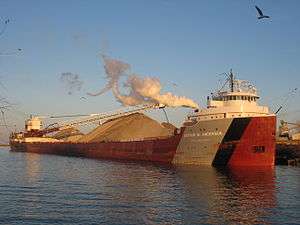SS Arthur M. Anderson
 SS Arthur M Anderson in August 2002 at a Duluth ore dock. | |
| History | |
|---|---|
| Name: | SS Arthur M. Anderson |
| Namesake: | Arthur Marvin Anderson |
| Operator: | Great Lakes Fleet, Inc. |
| Port of registry: |
|
| Builder: | American Ship Building Company[1] of Lorain, Ohio |
| Yard number: | 868 |
| Launched: | 16 February 1952[1] |
| Acquired: | 7 August 1952 |
| Identification: |
|
| Status: | In service as of 2016 |
| General characteristics | |
| Class and type: | AAA class of lake freighter |
| Tonnage: | 26,525 gross tonnage[1] |
| Length: |
|
| Beam: | 70 ft (21 m)[1] |
| Draft: | 36 ft (11 m)[1] |
| Capacity: | 25,300 tons [1] |
SS Arthur M. Anderson is a cargo ship of the laker type. It is famous for being the last ship to be in contact with SS Edmund Fitzgerald before Edmund Fitzgerald sank on 10 November 1975. Arthur M Anderson was also the first rescue ship on the scene in a vain search for Edmund Fitzgerald survivors (there were none). The vessel's namesake, Arthur Marvin Anderson, was director of U.S. Steel at the time.
History
SS Arthur M. Anderson came out of the drydock of the American Ship Building Company of Lorain, Ohio in 1952.[1] It had a length of 647 feet (197 m), a 70-foot (21 m) beam, a 36-foot (11 m) depth,[1] and a gross tonnage of roughly 20,000 tons. It was second of eight of the AAA class of lake freighters; the others being, in order, SS Philip R. Clarke, SS Cason J. Callaway, SS Reserve, SS J.L. Mauthe, SS Armco, SS Edward B. Greene, and SS William Clay Ford. Arthur M. Anderson, along with Philip R. Clarke and Cason J. Callaway, were built for the Pittsburgh Steamship Division of U.S. Steel. Arthur M Anderson's sea trials commenced on 7 August 1952, and it loaded its first cargo at the Two Harbors dock on 12 August 1952. It received several refits in its life including the addition of a new 120-foot (37 m) midsection in 1975 which added about 6,000 tons to its gross tonnage, bringing the total to about 26,000 tons. In 1981 it received a self unloading boom which improved its cargo loading and unloading. It is unique among the three Great Lakes Fleet steamships in that it has a softer midsection that prohibits loading as much cargo as the others; roughly 1500 tons less.[1][3]
In February 2015 Arthur M. Anderson became stuck and stranded in several feet of ice in Lake Erie near Conneaut Harbor, Ohio.[4][5] Arthur M. Anderson was freed from the ice on 21 February 2015 after five days with the help of the Canadian Coast Guard vessel CCGS Griffon. CCGS Samuel Risley was slated to escort Arthur M. Anderson to Detroit. USCGC Bristol Bay had also become stranded while attempting to free the ship from the up to 10-foot (3.0 m) thick ice.[6]

It has been a member of the U.S. Steel fleet its entire life, and is still sailing as of 2016.
Notes
- ↑ During the winter of 1974–75, she was lengthened 120' by Fraser Shipyards, Superior, Wisconsin[2] to an overall length of 767 feet[1]
References
- 1 2 3 4 5 6 7 8 9 10 11 "Vessel Documentation Query". NOAA/US Coast Guard. 2009-04-29. Retrieved 2010-02-15.
- ↑ "Inland Seas". 31-32. Great Lakes Historical Society. 1975: 248.
- ↑ ABS trim and stability booklet
- ↑ Danylko, Ryllie (21 February 2015). "Coast Guard struggles to free freighter stuck in Lake Erie en route to Conneaut". cleveland.com. Retrieved 22 February 2015.
- ↑ Geftos, Tony (22 February 2015). "2 cutters to free freighter from Lake Erie ice". 13abc.com. Retrieved 22 February 2015.
- ↑ Danylko, Ryllie (22 February 2015). "Canadian Coast Guard rescues freighter trapped in Lake Erie ice". cleveland.com. Retrieved 22 February 2015.
External links
-
 Media related to Arthur M. Anderson (ship, 1952) at Wikimedia Commons
Media related to Arthur M. Anderson (ship, 1952) at Wikimedia Commons - AIS Tracking of SS Arthur M. Anderson via marinetraffic.com
- sailwx.info: Arthur M Anderson current position and weather